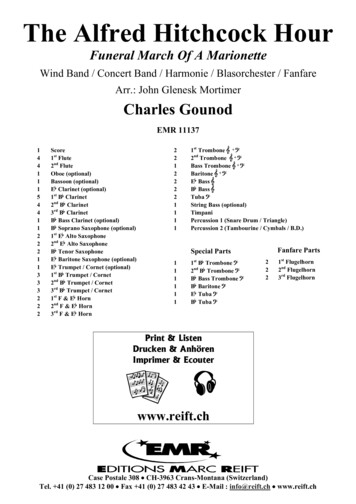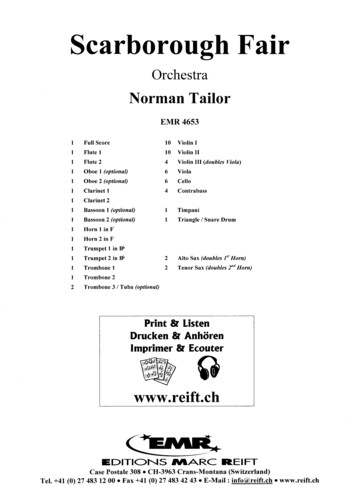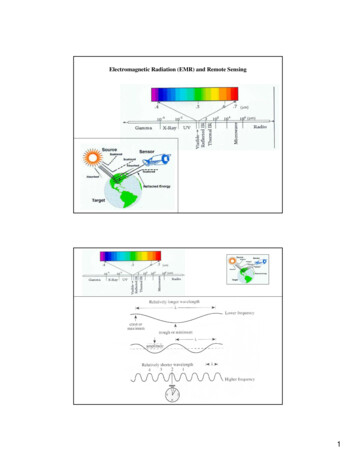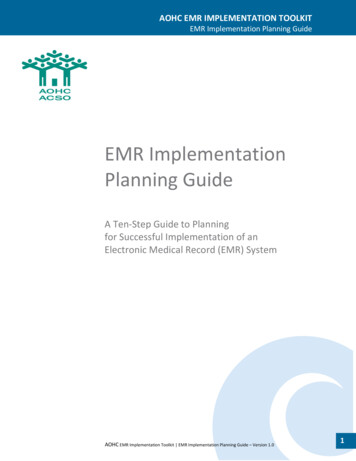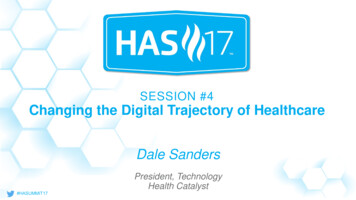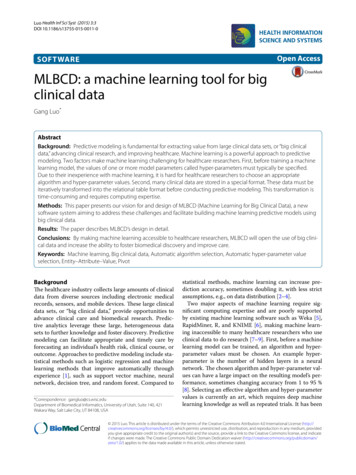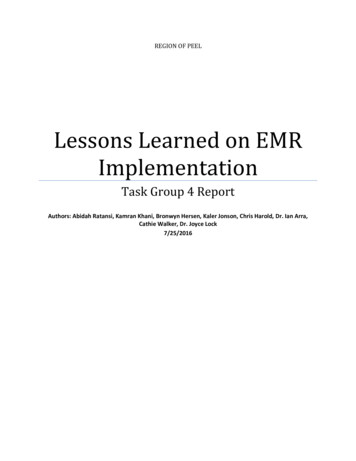
Transcription
REGION OF PEELLessons Learned on EMRImplementationTask Group 4 ReportAuthors: Abidah Ratansi, Kamran Khani, Bronwyn Hersen, Kaler Jonson, Chris Harold, Dr. Ian Arra,Cathie Walker, Dr. Joyce Lock7/25/2016
1Table of ContentsExecutive Summary. 2Background . 2Scope . 2Method . 4Results . 6Major Themes . 6Minor Themes . 8Focused Themes . 8Recommendations . 9Conclusion . 12Glossary . 12Appendix A: Task Group Members . 18
2Executive SummaryThe Council of Medical Officers of Health (COMOH) Electronic Medical Records (EMR) WorkingGroup was established as a forum for Medical Officers of Health and Associate Medical Officers ofHealth to explore and provide recommendations on EMR and data standardization. To this end,Task Group 4 has prepared the Lessons Learned on EMR Implementation report to summarize thelessons learned by other health units and organizations who have already adopted an EMR systemand to share a glossary of terms to ensure a consistent use of terms for clear communication andunderstanding.This report presents the findings from interviews conducted with representatives of thirteen healthorganizations throughout Ontario. These findings are intended to help inform the COMOH EMRWorking Group as they deliberate on pursuing a standard EMR system for public health.BackgroundIn 2015, the Council of Medical Officers of Health (COMOH) established an Electronic MedicalRecords (EMR) Working Group. This working group was mandated to:i)Explore and provide recommendations on a standard EMR system for all Ontario publichealth units;ii)Provide recommendations for data sharing and access between public health units; and,iii)Provide recommendations on standardized data elements of EMR systems to enable datasharing and reporting in Ontario.To support the first of COMOH EMR Working Group goals, five Task Groups were established:Funding, EMR Requirements, Cost and Benefits, Lessons Learned, and EMR Strategy. Task Group 4(TG4), which focused on Lessons Learned, conducted an investigation into the EMR deploymentexperiences of public health units.ScopeInformation SourcesA total of 15 candidate organizations were identified by the COMOH EMR Working Group as havingEMR software in active use, qualifying them as key informants. Task Group 4 elected to expand thelist of organizations beyond public health units to include the Association of Ontario Health Centresgiven their experience in implementing an EMR across 75 different community health centresacross Ontario using a standardized process. Long Term Care centres were considered, but notincluded in the final list.Eight organizations were identified as using EMRs certified by OntarioMD – an eligibilityrequirement for organizations to apply for MOHLTC EMR funding, and for an EMR to be guaranteedto be interoperable with provincial EHR solutions.
3Table 1a: Use of OntarioMD Certified EMROrganizationNorthwestern Health UnitCity of Hamilton Public Health ServicesKingston, Frontenac and Lennox & Addington Health UnitTimiskaming Health UnitNorth Bay Parry Sound District Health UnitWellington-Dufferin-Guelph Public HealthRegion of Waterloo Public Health and Emergency ServicesAssociation of Ontario Health Centres (AOHC)EMR Software NameXWave / QHR AccuroOSCAR EMROSCAR EMROSCAR EMRPS Suite EMRExcelicareNightingale OnDemandNightingale OnDemandAn additional seven public health units used non-OntarioMD-certified EMR software. These werealso included in the final list of key informants.Table 1b: Use of Non-OntarioMD-Certified EMROrganizationAlgoma Public HealthDurham Region Health DepartmentBrant County Health UnitNiagara Region Public HealthPorcupine Health UnitToronto Public HealthSimcoe Muskoka District Health UnitEMR Software ey InformantsCandidate organizations were approached and asked to provide contact information for keyinformants (i.e., the individuals best able to answer questions about EMR deployment experience atthe organization). Thirteen of the 15 organizations identified at least one key informant toparticipate in the TG4 investigation. Key informants for the remaining two organizations could notbe identified within available time constraints.Table 2: TG4 Key InformantsCandidate OrganizationAlgoma Public HealthKey Informant(s)Christina Luukkonen, Executive Assistant to the MedicalOfficer of Health / Chief Executive Officer and Secretaryto the Board of HealthPerry Robertson, Senior Software DeveloperAssociation of Ontario Health CentresBrian Sankarsingh, Transition LeadBrant County Health UnitNone identified
4City of Hamilton Public Health ServicesDebra Clarke, Project Manager, Continuous ImprovementDurham Region Health DepartmentPaula Hanley, Manager, Infectious Disease Preventionand ControlKingston, Frontenac and Lennox &Addington Health UnitFairleigh Seaton, Manager, Vaccine Preventable DiseasesNorth Bay Parry Sound District HealthUnitKatie Dortono, Medical Informatics AnalystKathy Bell, Manager, Sexual HealthJamie Hetherington, Business Support Analyst, ITSDiane Vanecko, Director of Organizational andFoundational StandardsRick Taus, Manager Information Technology, Building &Maintenance, Quality AssuranceNorthwestern Health UnitGillian Lunny, Manager of Sexual HealthPorcupine Health UnitNone identifiedRegion of Waterloo Public Health andEmergency ServicesChris Harold, Manager, Information and Planning,Infectious Diseases, Dental and Sexual Health DivisionSimcoe Muskoka District Health UnitReina Barker, Manager of Health ConnectionTimiskaming Health UnitDr. Marlene Spruyt, Medical Officer of Health and CEOToronto Public HealthJoanna Liebert, Manager Quality Assurance, CQI TCHISWellington-Dufferin-Guelph PublicHealthTom Craig, Manager, Operations and ITNiagara Region Public HealthMethodSelection of MethodDue to the high degree of variability in deploying different software in different organizationsunder different conditions, qualitative methods were used to gather data on each health unit'sdeployment experience.To achieve the goal of gathering information regarding lessons learned by the healthcareorganizations, three potential methodologies were evaluated: online survey, one-on-one interviews,and focus groups.The online survey method was considered the fastest and simplest way to gather information;however, it was rejected due to the difficulty in obtaining a sufficient level of detail from keyinformants. The focus groups method was considered a good strategy for eliciting a wide range ofperspectives and identifying themes, but this was rejected due to significant scheduling complexityand the potential to suppress nuances of experience only expressed by a minority of organizations.
5Despite being potentially time-intensive, one-on-one interviewing was selected as the preferredmethodology due to the ability to gather detailed information. The time investment was mitigatedby sharing the interviewing responsibility across TG4 members. Due to geographical distribution,TG4 decided to conduct all interviews via telephone.Interview ProcessThe one-on-one interview method included three stages: preparation, interview, and validation. Astandard list of questions and context considerations were developed to provide interviewstructure and to prime key informants in advance (refer to Table 3). In the preparation stage, keyinformants were asked to consider the questions and context considerations in advance and conferinternally on any areas of uncertainty (refer to Table 4). Key informants were also asked to provideany additional documentation that was readily available and shareable per local confidentialitypolicy.Table 3: List of Interview QuestionsQ# Question1What worked well that was in your control?2What did not work well?3What is the one piece of advice you would give to a PHU planning to implement an EMR?4What were the keys to success?5Were there any surprises (costs, support, timeline, etc.)?6Assuming the current system does not meet all of your needs, what trade-offs did you decideto make?7Did you collaborate with other PHUs using the same EMR system? If yes, in what ways didyou collaborate (e.g., shared governance model, jointly procured to influence costs, etc.)?What were the outcomes of collaboration?8Would you like to share anything else that we may have missed?Table 4: Context ConsiderationsTopicDetails to ConsiderPlanningPre-procurement considerations Funding availability Costs (initial and ongoing) Requirements gathering Project management Staffing and resources CommunicationProcurement considerations RFQ, RFP Accessibility (AODA Compliant) Privacy and security updates Contingency planning (e.g., fordowntime) Support provided by EMRvendor (implementation, techsupport) Data migration
6TopicDetails to Consider ImplementationEvaluation Compatibility of provinciallymandated systems such as iPHISand Panorama (interoperability)Project managementChange managementStaff trainingStaffing and resourcesIssues faced by usersCommunicationProgram Evaluation (formal/informal)Cost-benefit analysis / return on investmentGap analysis (compared to initial expectations of system/project)DowntimeUsage (within the Public Health Division/Programs)Interviews were completed via phone calls at times negotiated individually between interviewersand key informants. During the phone calls, typically 40 to 60 minutes in duration, interviewersasked the questions indicated in Table 3 and documented the responses in a standardizedworksheet.In the validation stage, interview worksheets completed by the interviewers were shared withinterviewees. The interviewees were asked to review the notes for accuracy and completeness, aswell as offered the opportunity to add to the notes if desired. Once validated by the interviewees,the interviewers shared the final interview worksheets with the other TG4 members for themeextraction.To complete the theme extraction, each TG4 member was assigned one or more questions andexamined them for repetition. In addition, members cut and sort the various responses to aparticular question in order to form overarching themes. The TG4 members then together reviewedthe extracted themes. In this process, the TG4 members identified that there were some themesthat were found in responses to most questions. These themes were considered major themes.Themes that less frequent across questions were considered minor themes. Themes that were onlyfound in one particular question were considered focused themes.ResultsThe following themes were identified using the process outlined above.Major ThemesProject Management:
7The project management team must be structured in a way that is both representative of everyoneinvolved in the deployment effort and effective at making decisions and completing tasks in atimely manner. A single dedicated project lead with a full-time responsibility ensures that there isoverall coordination and maintains forward momentum in all areas. A multidisciplinary teamincluding business and technical representatives, as well as subject matter experts, maximizesorganization and helps foster ongoing relationships. A shared work plan that includes all roles andresponsibilities minimizes confusion and ensures that each member works as effectively aspossible. It also enables sufficient resource allocation and allows a shared understanding of thework involved by both the project team and senior management. Finally, establishing a clearcommunication plan from the beginning supports effective and ongoing communication betweenand with stakeholders.Ongoing Support for All Staff through the Learning and Maintenance Phases:Staff buy-in is incredibly important as they are the users who will physically be inputting the data. Ifproject management teams only rely on voluntary feedback, they may only hear from staffmembers who are comfortable with the technology. This group is likely unrepresentative of all thestaff, and may not consider those who use technology less often. Teams must be prepared tosupport these staff members as they “catch up” to where they need to be. The project does not endwith “going live” and this support cannot stop when the system is implemented. Without ongoingsupport for staff through both the implementation and maintenance phases, the project will fail.Incremental Implementation:Rollout must happen in phases in order to keep work manageable and limit the impact of glitches.Prioritized implementation allows issues to be fixed before teams shift their focus to the next phase.A clear timeline and workflow from the beginning ensures that the project moves along smoothly ina timely manner and that teams never lose sight of the ultimate goal of developing a system thatworks for the end user. In addition, it is important to ensure that the project team understands thesystem being implemented, particularly the back-end, as decisions at the start of the process willimpact future implementationCustomization will require Vendor and IT Support:To be usable for public health units (PHUs), the EMR system will likely need to be customized forpublic health work. The system provided by the vendor is a base product, and the EMRs mayrequire a large amount of customization, especially in regards to: privacy (access restrictionsbetween programs), reporting capabilities, and data sharing mechanics (geography, sending data,provider as a PHU vs. provider as a physician). Interviewed organizations pointed out that lots oftime can be wasted in this redevelopment because teams must try to retrofit something that wasnot originally designed to do what they needed it to do in the first place.The initial tools/ templates provided by the vendor to describe required customizations andworkflows generally do not work for PHUs. Therefore, the customization of the EMR system topublic health requires the coding of new tools and templates. Interviewed organizations feel thattremendous IT resources are required to make such changes. In addition, teams will need ongoingsupport in terms of database changes and technical upgrades. This is an area that can be difficult toask for from vendors and can dramatically increase costs of implementation. Chasing a vendor for
8support delays project implementation, causes loss of momentum, and ultimately costs valuabletime and money.Nevertheless, the time and resources that PHUS must dedicate to customization will prove to beworth it in the end, as developing one’s own system and structuring in advantages for one’s ownusers increases buy-in to the end-products. Therefore, it is important to have an ongoing plan formaintenance and support even after launch.Minor ThemesRole of Front Line Staff during Implementation:Involving administrative and front line staff in the design and testing phases is an effective way toincrease buy-in and allow for feedback. In addition, it is a proactive approach for preparing forupgrades and making changes. It also helps in the development of workflows.Funding:The possibility of funding being limited is always a reality; for example, the Ministry of Health andLong-Term Care withheld providing onetime funding for EMR requests. Without consistent fundingthere is a risk for implementing from a narrow and siloed perspective, rather than implementingthe agency vision.Have a Good Understanding of the Ongoing or Hidden Costs:Some functionality additions may be expensive and there may be increased maintenance costs.Having unexpected costs may slow down development and implementation.Business Process Change Management:Change management strategies can be used to generate end-user buy-in. Engaged staff and afunctioning system makes roll-out much easier, so it is important to communicate with staff andclients open and honestly. It is important to involve end-users via formal feedback andcommunication methods to help identify issues, needs, and gaps in planning. Without a trackingsystem of the complaints being made by staff and clients, organizations may have difficultyassessing the usefulness of the system.Data Migration:Data in raw-text format requires local IT work to write a script/ engine to import data. Inputtingvaluable data will make the EMR more informative; inputting historical data that is too old orunnecessary will just slow down the implementation process. Therefore, it is a good idea to archivedata if it will not be valuable in the new system.Focused ThemesCollaborationCollaboration between PHUs is beneficial, as it may increase leverage for vendor developments. Ithas been demonstrated that an open source system facilitates such collaboration.
9Partnership has occurred between health units on the same system as more experienced healthunits will sometimes share coding, forms, and knowledge. However, collaboration can be difficultbecause it elongates timelines and not all health units are at the same state of readiness. In addition,regardless of the system in use, the variation in business processes between health units ultimatelyleads to differences in functionality.Health units have also benefitted from knowledge of other health organizations that are on adifferent system as their lessons learned are applicable to all health information technologyprojects.Trade-Offs:The most common trade-off identified by organizations was increasing complexity of EMR recordsmanagement in order to meet their entire set of requirements. Needs and requirements were oftenidentified in a vacuum and tailored to meet the current business processes. Organizations rarelyconsidered revising business processes or reducing scope in order to simplify or reducerequirements and keep records management simpler. For example, organizations often accepted anincrease in staff workload or a longer deployment timeline in order to manage staff buy-in, or meeta particular need or resource limit. Furthermore, increased maintenance cost has also beenassociated with either meeting needs or reducing initial costs. On the other hand, increasedindividual client functionality reflects a core challenge in the software market. The majority ofsoftware is designed for primary care (one-client, one-provider situations), and is not capable ornot effective where the “client” is not an individual, as in public health practice. Again, needs andbusiness processes must be examined to ensure that the trade-off is necessary.RecommendationsThe following recommendations come out of the lessons outlined in the previous section.Project Management:Use project management methodology with a project leader who is supported by a steeringcommittee or project management team. Choose representatives for the project management teamwho have different skill sets and/ or represent different groups of end-users. IT is an essentialmember of the team.Establish project charters early on to ensure common understanding of scope and deliverables.Project charters should be used to define the scope of the project, how the project is being rolledout, the roles and responsibilities of the project team and staff, and the limits to roll-out. It isespecially important the project lead prioritizes this project and does not get distracted by otherresponsibilities. Keep returning to the project charter as the project progresses to minimize scopecreep. In addition, the team should prepare themselves by having business processes analyzed inadvance of implementation. Finally, build a buffer into the timelines to plan for inevitable changesand delays.Ongoing Support for All Staff through the Learning and Maintenance Phases:
10Create mechanisms for all staff to provide input into database implementation. Establish consistentand clear expectations for staff performance in terms of their roles and responsibilities with respectto the system. Build in a large number of super-users at the program level, as they will ensure thatsupport is structured in, and be prepared with replacements should any of the super-users need tostep down due to fatigue, job changes, and turnover. In addition, it is important that systemmaintenance and support is included in the project scope. Finally, communicating with the staffearly on and regularly to demonstrate the value of the EMR system will enhance buy-in and useracceptance.Incremental Implementation:Limit initial implementation to one or two teams. This allows organizations to work out the kinksbefore rolling out to other teams in a phased manner. The teams who get to implement the systemfirst should be chosen objectively based on who would benefit the most.Start small and expand in increments. Build the most need functionality (must haves) first.Additional functionality can be added with subsequent releases. It is important that staff membersare clearly told that initial improvements will be confined to processes that contribute to plannedroll-out and that opportunities to develop the system will become available later on.Customization will require Vendor and IT Support:Establish clear requirements for how the EMR system can meet public health needs. Have a clearagreement with the vendor about the system’s ability to service public health functions and howmuch customization will be needed. Choose a system that requires as little customization aspossible, and/or factor in the amount of work required for customization.Contact other PHUs to see what system they are using and determine their vendor satisfaction. Iforganizations choose to use the same vendor, they can also ask if the other PHUs would be willingto act as a support mechanism. Organizations can negotiate ongoing support as part of their requestfor proposal (hours, costs, what is included in terms of services, etc.). They should not wait to figureout these details later on in the implementation process.Be sure to have enough buy-in from Corporate IT to have a sufficient amount of technical resourcesto change the setup/ structure of the system. Have in-house expertise available as well to customizetemplates. If someone on the project management team can serve as the bridge between IT andPractitioners, the customization process will be much more efficient and much less confusing.Programs must also be prepared to potentially adapt their business processes to the EMR system.Commit to developing a solution that works for the end user by focusing on the end-user’sworkflow and needs. Develop a collaborative relationship with IT so that they can understand whatthe workflow is and why it is important. This relationship will ensure that they commit to theproject themselves and keep pushing to find solutions when problems arise.Role of Front Line Staff during Implementation:
11Involve front line staff from the beginning of the project and keep them informed throughstructured communication methodologies.Funding:Secure funding. PHUs may want to consider looking outside of the traditional funders. For example,they may look to universities affiliated with a particular vendor or to cost sharing with otherorganizations.Have a Good Understanding of the Ongoing or Hidden Costs:Have a clear agreement with the vendor about costs and hidden costs. Dividing the implementationprocess into phases reduces immediate costs. In addition, frequent reviews of processes and needsare important to determine whether the ongoing costs are absolutely necessary.Business Process Change Management:Manage expectations and be open to ideas provided by front line staff. Consider using a ticketingsystem and monitoring support requests to identify trends and source problems. Be prepared forworkflow and business processes to change when the EMR system is implemented. Understandwhen the entire system needs to be modified versus when smaller changes to the workflow will besufficient to meet the needs of the change requests. Ask the following three questions throughoutimplementation. Should the planned scope of use be modified to keep records management simple?Can the defined needs be reduced or simplified in order to avoid escalating records managementcomplexity? Can business processes be adapted to the EMR rather than setting up the EMR to meetall business process requirements?Data Migration:Avoid migration of old and unneeded data, as well as the scanning in of documents. Instead, it ismore efficient to automate the migration process. Even though automation slows down the initialsetup, it will raise the accuracy of the data, as it will verify the information, rather than just enter inthe data.Collaboration:Consider standardization approaches, as well as approaches to mitigate variation across healthunits, to be able to collaborate with other health units that are on different systems. In addition,consider assessing the state of readiness of health units when creating implementation plan.Consider using an open source system to facilitate collaboration with other health units. Identifymore experienced health units that have already established EMR systems and determine whetherthey are willing to share their knowledge with other health organizations. Consider exploringcreating shared models between health care units. In addition, once a vendor is chosen, considerdeveloping a strategic relationship with other organizations with the same vendor.Trade-Offs:Factor in workload change and increased maintenance cost to implementation plan as such changesare intrinsic to EMR deployment. As mentioned above, it is also useful to consistently reviewprocesses and needs to determine whether the ongoing costs are absolutely necessary.
12The wide variation in use-cases in public health leads to the need to accept a capability bias towardone particular capacity. It may be that no software exists that can meet all the needs of a PHUwithout requiring extensive customization and sacrificing usability and simplicity. This issue maybe an argument for health units collaborating on the development of a dedicated public health EMR,or developing consistent standards that all PHUs can follow if they use different EMRs.ConclusionThrough this report, COMOH EMR Working Group TG4 has sought to develop a greaterunderstanding of selected health organizations and Ontario public health units’ experiences withEMR implementation. In particular, TG4 has focused on what important lessons these organizationshave learned during their implementation processes. The findings from this report recommend thatplanning is critical to implementation success. Particular attention must be paid to the allocation ofboth the human and capital resources needed for system customization and system roll-out. Inaddition, these plans must be constantly reviewed and reassessed to minimize the wasting of suchresources.This report also provides below a glossary of terms to ensure a consistent use of terms for clearcommunication and understanding between all Task Groups.The findings from this report, along with the findings from the other reports prepared by the otherTask Groups will inform the COMOH EMR Working Group, and by extension the Medical Officers ofHealth and Associate Medical Officers of Health as they deliberate on pursuing a standardized EMRsystem for all Ontario public health units.GlossaryAnonymous Client: A client who declines to provide any demographic or personal informationother than a first name or an alias.Application Architecture: The design of the software and relationship between variouscomponents and how they interact.Application Platform Interface (API): The interconnection (“go between”) that allows onecomponent of one software program to communicate with another software program.BORN: Ontario’s Better Outcomes Registry & Network (BORN) was established in 2009 to collect,interpret, share and rigorously protect critical data about pregnancy, birth and childhood in theprovince.BIS: The BORN Information System (BIS) enables the collection of, and access to, data on everybirth and young child in Ontario. Sourced from hospitals, labs, midwifery practice groups andclinical programs, the data are collected through a variety of mechanisms including HL7, batchupload, and manual entry. Information is reported via standard reports and analytical tools withinthe BIS.
13Business Requirements: The critical activities of an application that must be performed
Funding, EMR Requirements, Cost and Benefits, Lessons Learned, and EMR Strategy. Task Group 4 (TG4), which focused on Lessons Learned, conducted an investigation into the EMR deployment experiences of public health units. Scope Information Sources A total of 15 candidate organizations were identified by the COMOH EMR Working Group as having
